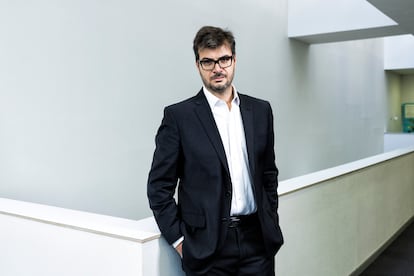Joan Camprodon, neuropsychiatrist: ‘There is a lot of taboo around electroconvulsive therapy, but it reduces the intensity of depression’
The transcranial magnetic stimulation specialist claims that the technique can help personalize treatments for various psychiatric disorders

When depression appears, it is usually combatted with drugs and psychotherapy, but these treatments leave many without relief. Transcranial Magnetic Stimulation (TMS) is an alternative for those who do not respond to the usual methods. The technique consists of applying magnetic fields to stimulate nerve cells and modulating their activity to reduce or eliminate depressive symptoms. Unlike other techniques, such as deep brain stimulation, it does not require surgery and allows the brain to be stimulated quite precisely. TMS has also proven useful against obsessive-compulsive disorder, tobacco addiction and migraines.
Joan Camprodon, 46, director of neuropsychiatry at Massachusetts General Hospital in Boston, is one of the world leaders of this type of treatment. A few days ago, he participated in a conference on neuromodulation organized by the Spanish Society of Clinical Psychiatry (SEPC) at the Infanta Sofía University Hospital in San Sebastián de los Reyes (Madrid). At the event, he spoke of the potential of a technology that helps patients who don’t respond to other therapies and that is set to be applied to more areas in the coming years.
Question. In the long term, can these tools replace medications for diseases such as depression?
Answer. Stimulation tools are becoming more precise and safer, but they will not necessarily replace medication. As a clinician, I believe that we have to have as many tools as possible, with maximum safety and maximum effectiveness, to be able to combine them in a way that is individualized. We don’t want to cure depression or schizophrenia, we want to cure a person suffering from depression or schizophrenia, and we need to personalize treatments. That’s important because depression is not a disease, it is a clinical syndrome. It is like a headache, which can arise because someone has migraines or intracerebral bleeding because they have hit their head. If I give an anti-migraine drug to three people who have a headache, only the people who have a migraine will respond; the person with the headache will continue to be in pain. Depression is the same, there are many different diseases that give rise to what we call depression, and the same treatment does not work for all of them.
Q. Can these techniques help improve knowledge about this clinical syndrome and its treatment?
A. Stimulation tools, which change the brain, are combined with tools that measure it, such as an MRI or PET (positron emission tomography), which allow us to understand, in a non-invasive way, what is happening in the brain when we apply a treatment. In this way, we know what is happening when the treatment does not work and what is happening when it works, and from there, we can design strategies to optimize how to induce the necessary changes in the emotional, cognitive or behavioral circuits of a person with depression.
Q. Is the application of these therapies expensive compared to other alternatives?
A. If compared to other stimulation tools or pharmacology, from a strictly economic point of view, beyond the personal and social impact, it is very effective, because it works very well with patients who are very resistant to treatment and very expensive to treat on a day-by-day basis. This economic vision is important when it comes to convincing politicians to allow these tools to be covered by the public health system: it still surprises me that they are not included, because the evidence is very strong. Deep brain stimulation is performed for Parkinson’s, but very little, and electroconvulsive therapy is performed, but only a little, and it comes late, because it is applied when the person has been suffering for 15 or 20 years, and has had many [hospital] admissions or suicide attempts. There is a lot of taboo around electroconvulsive therapy, but there is evidence that it reduces the intensity of depression, the risk of suicide, improves functionality and integration in the family. Electroconvulsive therapy is done differently than years ago. It does not require surgery, but it does require general anesthesia, with muscle paralysis, just like when you operate on someone. This avoids the risk of joint, muscle or bone injuries.
Q. Do you think we can aim to significantly reduce the impact of mental illness, or is it an inseparable part of being human?
A. It is a bit like cancer, the price we pay for the biological complexity of our body, for the cognitive complexity and behavioral and affective sophistication of our brain. This is not going away. The prevalence of schizophrenia, for example, is 1% in Spain, India, Nepal, the United States and Uruguay, it is very permanent.

Q. With this type of technique that is non-invasive, not very expensive and relatively easy to apply, is it possible for brain stimulation to be used not only for sick people, but to improve the abilities of healthy people?
A. Biologically it is feasible. A healthy brain can be modulated to maximize its functions. This is already done in elite athletic centers, with specific diet or sleep patterns, with cognitive training. A person who studies medicine for six years is optimizing his or her cognitive abilities. And technically it is possible to use our tools, not only to increase the level of function of a person who has a deficit due to a psychiatric or neurological disease, but to optimize it in someone healthy and also to prevent them from falling into a pathological state in the future. It is an important bioethical debate that we have to keep in mind in science and at a social level. Who will have access to these technologies? Maybe people who already have certain advantages and would increase that gap? Is putting a helmet on your head very different from studying 10 hours a day for a year and improving your ability to concentrate? They are important questions.
Q. Does this manipulation have risks?
A. When you change one thing, you change others, because everything is very connected. What is the risk of using these stimulation tools in a healthy brain, to, for example, increase attention? What other functions are downgraded? What mindfulness training can do is not that different from what stimulation can do, but there are different connotations. Where I see the most value is in prevention. What can I do to minimize the likelihood of changes that lead to the disease? What can I do so that a person who has had a stroke does not have a second one, or that someone who has suffered a traumatic event does not develop post-traumatic stress disorder? We could optimize the brain to make it resistant to disease.
Q. Are there side effects? Are they similar to those of other treatments?
A. They are very different, for one main reason. A drug passes into the blood and reaches all organs. For it to reach the brain, which is where you want it to go, it has to go to the liver, the heart and the muscles. And when it gets to the brain, it doesn’t just go to the parts you want it to reach, it hits everything. They are systemic treatments, and a large part of the side effects of the drugs have to do with that. In brain stimulation, except with electroconvulsive therapy, you only reach some parts of the brain, which means that the range of side effects is more limited, although, like any treatment, it has them.
Q. Does the fact that these types of treatment work mean that the brain is a machine that can be repaired, like when we take the car to the mechanic?
A. Reductionisms will always explain a problem poorly and there are biological reductionisms that try to reduce everything to nuts and bolts, which in this case would be electrical patterns or, as they used to say, chemical patterns. But thinking that everything is psychological or that these psychological processes are totally detached from biology is also reductionist. They are one and the same, two sides of the same coin. If I as a scientist bring tools to measure the brain, I am going to see the brain, and if I bring tools to measure the mind, I am going to see the mind. The object of study is complex. But an emotion does not stop being real because I can explain it to you in biological terms or because I can modulate it with brain stimulation.
Sign up for our weekly newsletter to get more English-language news coverage from EL PAÍS USA Edition
Tu suscripción se está usando en otro dispositivo
¿Quieres añadir otro usuario a tu suscripción?
Si continúas leyendo en este dispositivo, no se podrá leer en el otro.
FlechaTu suscripción se está usando en otro dispositivo y solo puedes acceder a EL PAÍS desde un dispositivo a la vez.
Si quieres compartir tu cuenta, cambia tu suscripción a la modalidad Premium, así podrás añadir otro usuario. Cada uno accederá con su propia cuenta de email, lo que os permitirá personalizar vuestra experiencia en EL PAÍS.
¿Tienes una suscripción de empresa? Accede aquí para contratar más cuentas.
En el caso de no saber quién está usando tu cuenta, te recomendamos cambiar tu contraseña aquí.
Si decides continuar compartiendo tu cuenta, este mensaje se mostrará en tu dispositivo y en el de la otra persona que está usando tu cuenta de forma indefinida, afectando a tu experiencia de lectura. Puedes consultar aquí los términos y condiciones de la suscripción digital.
More information
Archived In
Últimas noticias
Most viewed
- Sinaloa Cartel war is taking its toll on Los Chapitos
- Oona Chaplin: ‘I told James Cameron that I was living in a treehouse and starting a permaculture project with a friend’
- Reinhard Genzel, Nobel laureate in physics: ‘One-minute videos will never give you the truth’
- Why the price of coffee has skyrocketed: from Brazilian plantations to specialty coffee houses
- Silver prices are going crazy: This is what’s fueling the rally











































